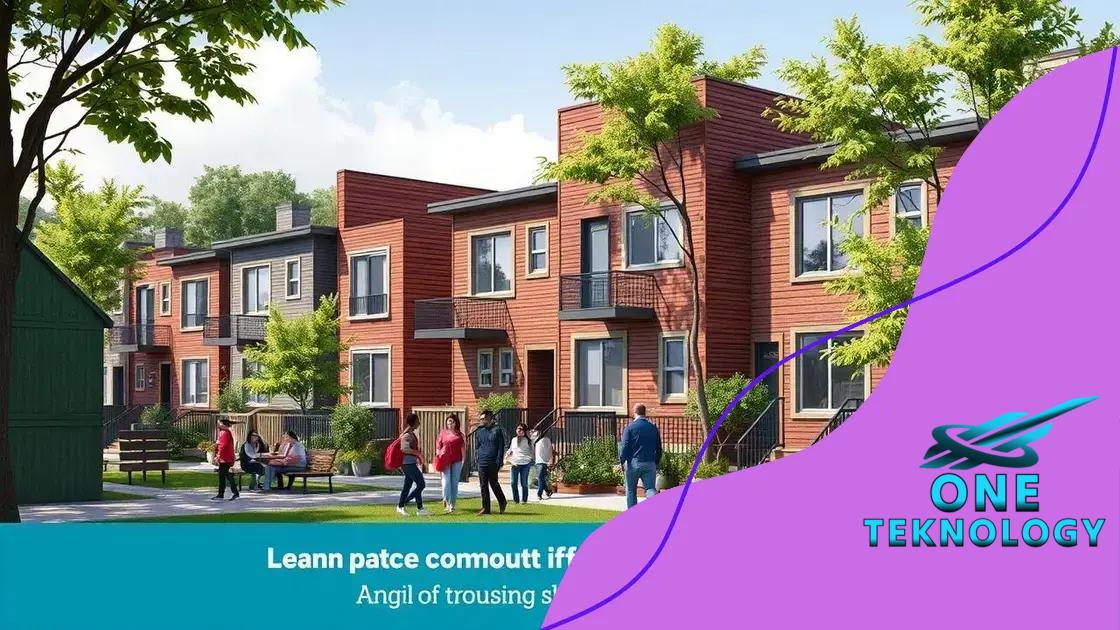Federal support for low-income housing in urban areas

Federal support for low-income housing in urban areas is crucial for improving living conditions, fostering community development, and providing affordable housing options to vulnerable populations.
Federal support for low-income housing in urban areas plays a crucial role in addressing homelessness and affordable living. Have you ever wondered how these programs shape neighborhoods?
Understanding federal support programs
Understanding federal support programs is essential for those looking to navigate low-income housing options. These programs offer much-needed assistance to individuals and families who struggle to afford housing in urban areas.
Various federal programs provide financial aid, rental assistance, and technical support. Among these, the most notable are:
Key Federal Programs
- Section 8 Housing Choice Voucher Program: This program allows low-income families to rent homes in the private market with the help of government subsidies.
- Public Housing Program: Managed by local housing authorities, this program offers affordable rental units directly to eligible residents.
- Low-Income Home Energy Assistance Program (LIHEAP): Provides financial assistance for energy costs to low-income households.
- HOME Investment Partnerships Program: This program provides grants to states and localities to create affordable housing for low-income residents.
Understanding these programs can unlock various opportunities for eligible families seeking affordable housing solutions. Each program has specific eligibility criteria and benefits to consider. Additionally, applying for assistance can sometimes be complex. Therefore, it is important to gather all necessary information and documentation before starting the application process.
Furthermore, different regions may have unique programs tailored to their specific housing needs. It’s crucial to research local options, as community-based support can significantly complement federal assistance. For instance, some cities offer additional housing vouchers funded by local government initiatives, enhancing what federal programs provide.
By recognizing the full range of federal support programs available, families can take informed steps toward securing stable housing. This understanding empowers them to make better decisions regarding their living situations and overall well-being, allowing them to focus on building a brighter future.
Eligibility criteria for housing assistance
Eligibility criteria for housing assistance are essential for understanding who can benefit from federal programs. Each program has distinct requirements that applicants must meet to qualify for support.
Common Eligibility Requirements
- Income limits: Most programs set a maximum income level that applicants cannot exceed. This limit varies based on family size and location.
- Citizenship status: Typically, applicants must be U.S. citizens or eligible non-citizens. Documentation may be required to verify this status.
- Residency: Applicants must generally reside in the area where they seek assistance. Proof of residency may be needed.
- Credit history: Some programs consider an applicant’s credit score and financial history to determine eligibility.
For many low-income families, understanding these requirements can make a significant difference. Applications are often intricate, and providing accurate information is crucial for success. While some programs focus solely on income, others may incorporate additional factors to determine eligibility.
Another key aspect is the application timeline. Many federal programs open and close enrollment at specific times throughout the year. Staying informed about these dates helps ensure families do not miss their chance to apply. Additionally, some programs allow for waitlists, giving families a potential pathway to housing assistance even if they don’t qualify immediately.
It’s also worth noting that eligibility can differ among states and localities. Therefore, families should research local housing authorities for more details on the specific requirements in their area. Connecting with local resources can provide valuable guidance and support throughout the application process.
Impact of federal funding on community development

The impact of federal funding on community development is significant, especially in urban areas struggling with low-income housing. These funds help revitalize neighborhoods, promote affordable housing, and enhance the quality of life for residents.
Key Areas Affected by Federal Funding
- Housing quality: Federal funds help to improve existing structures, ensuring homes meet safety standards and are livable.
- Infrastructure improvement: Investments often lead to better roads, parks, and public spaces, fostering a sense of community.
- Job creation: Construction and development projects funded by federal support can create jobs for local residents, boosting the economy.
- Social services: Additional funding can enhance public services like education and healthcare, contributing to overall community well-being.
Additionally, when federal funding focuses on low-income housing, it addresses pressing needs. Many families benefit from improved conditions, which can reduce homelessness and promote stability. This stability often leads to better educational outcomes for children as families have a secure place to live and study.
Moreover, community engagement plays a vital role in ensuring these funds are used effectively. Residents involved in the planning and development process can voice their needs, ensuring that projects align with the community’s vision. When community members feel heard, it fosters greater investment in their neighborhoods.
As federal funding continues to support urban areas, it is essential to monitor its impact. Tracking progress helps ensure that funds lead to meaningful change. Local governments and organizations need to collaborate effectively to maximize the benefits of these investments.
Case studies of successful housing projects
Case studies of successful housing projects provide valuable insights into how federal support can transform communities. These real-life examples demonstrate how effective planning and funding can yield positive results for low-income families.
Noteworthy Success Stories
- The Hope VI Program: This initiative aimed at revitalizing public housing across the United States has seen significant success in multiple cities. For instance, in Chicago, neighborhoods experiencing decay were transformed into vibrant mixed-income communities.
- San Francisco’s HOPE SF: This project focuses on replacing distressed public housing while providing additional community services. The program integrates affordable housing with essential support services, leading to improved living conditions.
- New York City’s Inclusionary Housing Program: This program encourages developers to include affordable units in new construction. By doing so, it expands access to housing in desirable neighborhoods, benefiting various income levels.
- Atlanta’s Turner Station Project: This community-driven effort aimed to replace aging public housing with new, affordable developments. In turn, it has fostered local engagement and economic growth.
These case studies illustrate the effectiveness of targeted funding and community involvement. When federal funding is combined with local expertise, the outcomes can vastly improve residents’ lives. Successful projects often highlight the importance of collaboration among government agencies, non-profits, and community members.
The lessons learned from these projects can guide future initiatives, emphasizing what works in real-world situations. They offer a glimpse into how to tackle common challenges such as funding shortages, bureaucracy, and community resistance. By evaluating both successes and areas for improvement, stakeholders can refine their approaches to housing assistance.
Future of low-income housing initiatives
The future of low-income housing initiatives is an important topic that addresses the evolving needs of communities. As urban populations continue to grow, the demand for affordable housing solutions becomes increasingly critical.
Emerging Trends in Low-Income Housing
- Increased public-private partnerships: Collaborations between government agencies and private developers are likely to increase. These partnerships can lead to innovative funding solutions and more efficient project timelines.
- Sustainable building practices: Future initiatives may emphasize eco-friendly designs and materials. This approach not only helps the environment but can also reduce utility costs for residents.
- Technology integration: The use of technology in housing applications, such as online platforms for applying for assistance, will likely improve accessibility and streamline processes.
- Community involvement: Engaging residents in the planning and decision-making processes can lead to better outcomes, ensuring developments meet the specific needs of the community.
In addition to these trends, policymakers will need to remain adaptive. Economic fluctuations and social changes can impact housing markets. Therefore, flexibility in policies and funding will be crucial to respond effectively to new challenges.
Furthermore, addressing racial and economic disparities in housing will be a primary focus. Programs aimed at reducing inequality can pave the way for fairer access to housing opportunities.
Ultimately, the future looks promising for low-income housing initiatives. With an emphasis on collaboration, sustainability, and technology, there is hope for creating more equitable housing solutions that can benefit all community members.
In conclusion, addressing low-income housing initiatives is a critical step in building stronger, more equitable communities. The focus on federal support, innovative approaches, and community engagement can lead to significant improvements. By continuing to adapt and learn from successful case studies, we can foster environments where everyone has access to safe and affordable housing. Together, we can create a brighter future for our urban areas, ensuring that all individuals and families have the opportunity to thrive.
FAQ – Frequently Asked Questions about Federal Support for Low-Income Housing
What types of federal programs assist low-income housing?
Programs like Section 8, LIHEAP, and the HOME Investment Partnerships are designed to provide financial aid and support to low-income families seeking housing.
How can I find out if I’m eligible for housing assistance?
Eligibility is typically based on income, residency, and family size. Check with your local housing authority for specific criteria.
What role does community involvement play in housing initiatives?
Community involvement ensures that the needs and desires of residents are considered, leading to more effective and satisfying housing solutions.
How do successful case studies influence future housing projects?
Successful case studies provide insights and best practices that can be applied to new projects, helping to avoid previous mistakes and improving overall outcomes.






